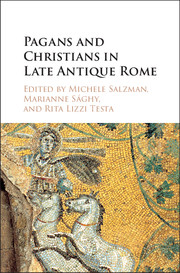 Pagans and Christians in Late Antique Rome
Pagans and Christians in Late Antique Rome from Part II - The Construction of New Religious Identities
Published online by Cambridge University Press: 05 November 2015
Now that new contributions have been made to the study of “the imperial cult” in the early Roman Empire, the time is ripe to broaden that conversation: by drawing attention to imperial cult practices in the late Roman world. This topic will provide an excellent illustration of how our modern categories, like “Roman/Christian” or “pagan/Christian,” fail to capture the nuances of social life in the late Roman world. Two recent studies – one focusing on divus Constantine, the other on the iconography of Christ as the heavenly emperor – have already begun to sketch out that picture.
This contribution expands on that work by examining the social and cultural context of one inscription from Rome (CIL 6.1783). This inscription has recently been used to characterize the late fourth and early fifth centuries as a period of “Christian triumph” and “pagan revival” although that narrative no longer withstands scrutiny. Traditional worship practices did not vanish with the conversion of Constantine; and abundant epigraphic, legal, numismatic, and textual sources, discussed here, attest to the continued practice of naming late antique emperors divi – including references to the diva memoria of the eastern Roman emperor Zeno (474–91 CE) and one reference to divus Anastasius (491–518 CE). Given this context, it is surprising, however, that no scholar to date has chosen to discuss the fact that the inscription from Rome names the emperor Theodosius as divus.
This chapter rereads that inscription in light of the resilience of traditional Roman worship practices in the fourth century, including imperial cult practices. In doing so, it suggests a model for understanding how the same social and cultural mechanisms by which individuals and communities drew the attention and patronage of the imperial house, as in earlier periods, remained an important “transactional” mechanism for brokering social relations in the late antique world. This chapter may challenge scholars who see “the imperial cult” as a phenomenon inherently in tension with early Christianity or as one whose outward “pagan” trappings were thrown off with the legalization of Christianity.
Rome, circa 431 CE
Few inscriptions have merited their own monograph. CIL 6.1783 is privileged to count among this group. Discovered in Rome in 1849 in the Forum of Trajan, the inscription dates to 431 CE and preserves a letter from Flavius Theodosius II and Flavius Valentinian III to the Senate of Rome.
To save this book to your Kindle, first ensure [email protected] is added to your Approved Personal Document E-mail List under your Personal Document Settings on the Manage Your Content and Devices page of your Amazon account. Then enter the ‘name’ part of your Kindle email address below. Find out more about saving to your Kindle.
Note you can select to save to either the @free.kindle.com or @kindle.com variations. ‘@free.kindle.com’ emails are free but can only be saved to your device when it is connected to wi-fi. ‘@kindle.com’ emails can be delivered even when you are not connected to wi-fi, but note that service fees apply.
Find out more about the Kindle Personal Document Service.
To save content items to your account, please confirm that you agree to abide by our usage policies. If this is the first time you use this feature, you will be asked to authorise Cambridge Core to connect with your account. Find out more about saving content to Dropbox.
To save content items to your account, please confirm that you agree to abide by our usage policies. If this is the first time you use this feature, you will be asked to authorise Cambridge Core to connect with your account. Find out more about saving content to Google Drive.